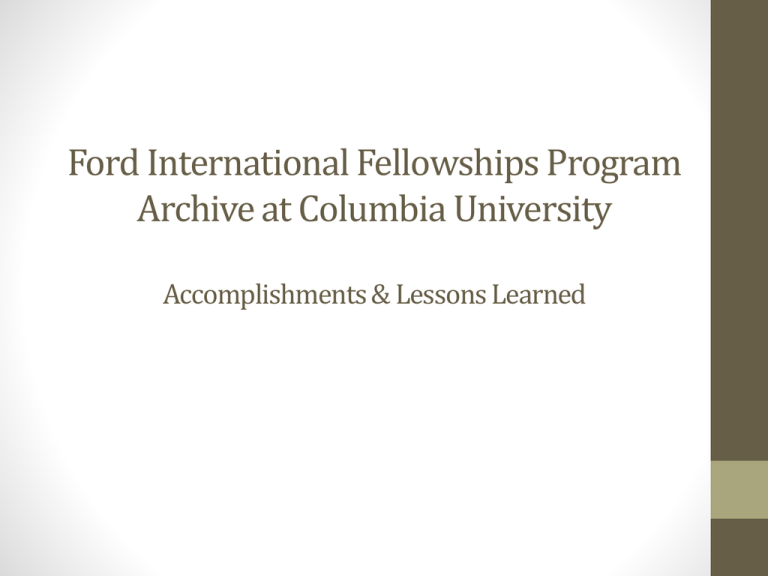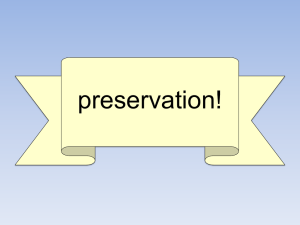Ford International Fellowships Program Archive at Columbia University Accomplishments & Lessons Learned
advertisement

Ford International Fellowships Program Archive at Columbia University Accomplishments & Lessons Learned Columbia’s tasks … • To house and make accessible IFP’s archives • But also …. Ford IFP Grant Key Objective: “… to enable Columbia Libraries to build out a full set of repository-based systems and services so that it can more easily acquire, ingest, process, preserve and make accessible both the paper and born-digital organizational records. The technological infrastructure built for this project will ultimately allow Columbia act as the central repository for the electronic records of other institutions whose archives are deposited at Columbia.” Bird’s Eye View Lessons Learned … #1. How to build a robust, extensible, standards-based, open-source local workflow for born-digital content preservation from soup to nuts. What does our new infrastructure do? Helpful to have a very quick overview of what it is we have built so the lessons learned can be understood in context. Born-Digital Content Preservation • Stage 1: Negotiate & work with / scope & advise content owners before content transfer • Stage 2: Arrange for transfer of content: hard media preferred • Stage 3: Receive and accession content in curatorial division • Stage 4: Create preliminary documentation • Photograph transfer media • Create preliminary metadata for transfer media • Stage 5: Read in content: Use digital forensics tools as needed to read media / copy content (e.g., FRED) Born-Digital Preservation, cont. • Stage 6: Check and validate content • Create detailed inventory manifest • Perform fixity checks • Perform virus checks • Stage 7: Create archival master of original content • Stage 8: Perform ‘appraisal’ • Content review (using FTK as needed) • Content weeding, if needed • Content reorganization, if needed • Stage 9: Create Ingest Package (SIP) • Stage 10: Create full set of structural, preservation and rights metadata; optionally create preservation derivatives (Archivematica) Born-Digital Preservation, cont. • Stage 11: Generate Archival Information Package (AIP) • Stage 12: Ingest into Preservation Repository (Fedora) • Stage 13: Generate preservation and/or access derivatives as needed and integrate into original Fedora content Lessons Learned … • Archivematica is a great open-source application! • Software development deadlines slip (we knew that) • Over the last two years, ‘tooling’ in this domain has developed rapidly and continues to develop • Working with content owners is highly desirable and very tricky • The concept of a digital “original archival artifact” is very tricky • There are more data formats floating around than you think there are (we’re up to 170 and counting) • No one knows how best to preserve ‘databases’ and ensure their accessibility in the future • Preserving and making accessible email is very challenging Biggest Challenge … Sorting through and addressing confidentiality requirements Our agreement with IFP: • Content would come to us sorted into three categories: • Publicly accessible • Viewable only onsite • Embargoed until 2075 • In retrospect, probably too ambitious a task for small offices in developing countries in their last weeks of operation Access restrictions … • Now requires substantial manual remediation • In 18 languages • Uncertainties remain about accuracy of status assignment and risk presented by possible errors • We need to build new level of security and access functionality for our preservation repository and effective take-down mechanisms In sum … • The project was all that we expected it to be and more …. • We have already built a workflow and digital processing infrastructure that will serve this project and other borndigital projects in the future • That infrastructure will continue to evolve and will need ongoing investment to stay current • There are many born-digital preservation challenges we will need to work on with colleague institutions • This is an entirely new programmatic area for CUL/IS currently resourced chiefly by grant funds Thank you.

